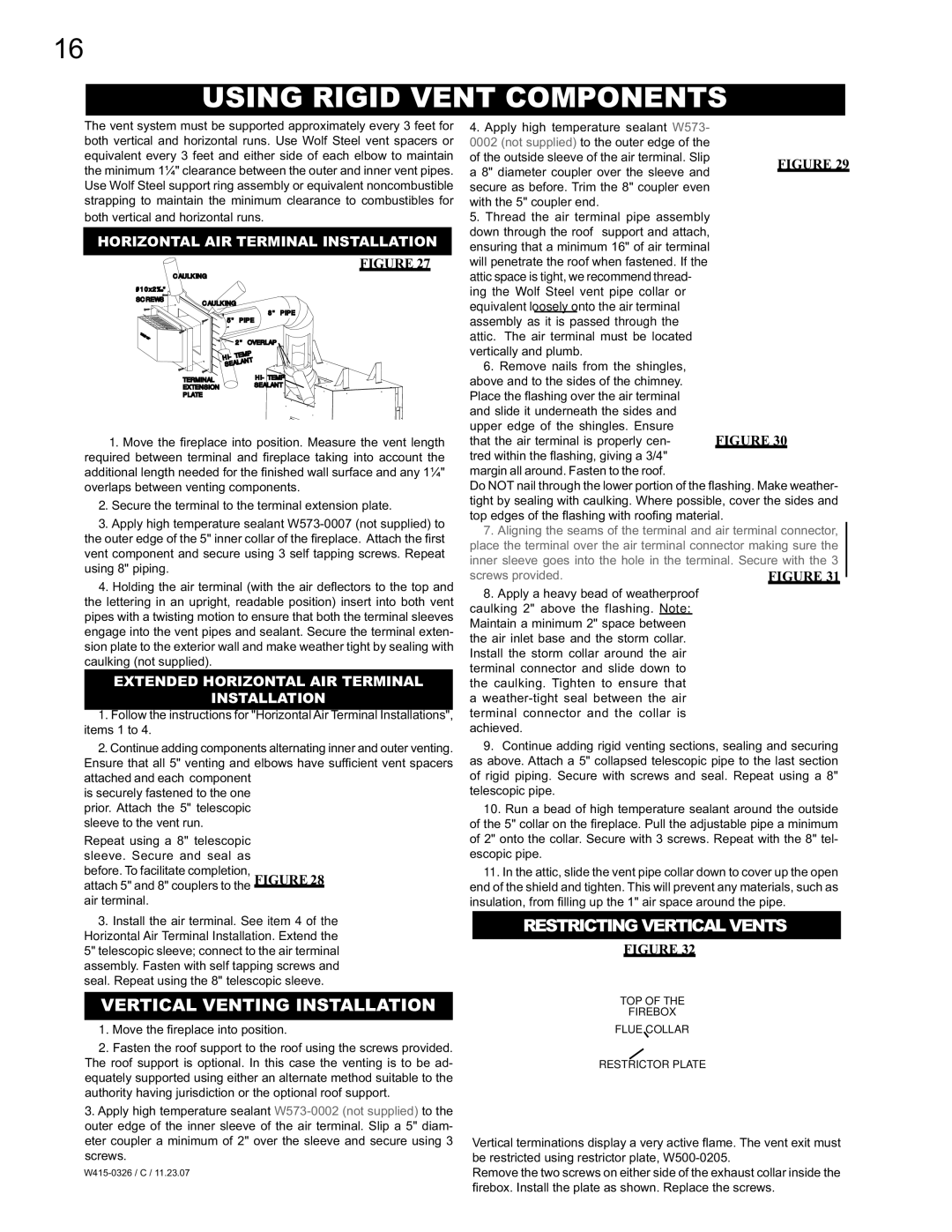The vent system must be supported approximately every 3 feet for both vertical and horizontal runs. Use Wolf Steel vent spacers or equivalent every 3 feet and either side of each elbow to maintain the minimum 1¼" clearance between the outer and inner vent pipes. Use Wolf Steel support ring assembly or equivalent noncombustible strapping to maintain the minimum clearance to combustibles for
both vertical and horizontal runs.
HORIZONTAL AIR TERMINAL INSTALLATION
FIGURE 27
CAULKING
#10x2½" | | |
SCREWS | CAULKING |
|
| | 8" PIPE |
| 5" PIPE |
| | 2" OVERLAP |
| | P |
| TEM |
| HI- | ANT |
| SEAL |
TERMINALHI-TEMP
EXTENSIONSEALANT
PLATE
1.Move the fi replace into position. Measure the vent length required between terminal and fi replace taking into account the additional length needed for the fi nished wall surface and any 1¼" overlaps between venting components.
2.Secure the terminal to the terminal extension plate.
3.Apply high temperature sealant W573-0007 (not supplied) to the outer edge of the 5" inner collar of the fi replace. Attach the first vent component and secure using 3 self tapping screws. Repeat using 8" piping.
4.Holding the air terminal (with the air defl ectors to the top and the lettering in an upright, readable position) insert into both vent pipes with a twisting motion to ensure that both the terminal sleeves engage into the vent pipes and sealant. Secure the terminal exten- sion plate to the exterior wall and make weather tight by sealing with caulking (not supplied).
EXTENDED HORIZONTAL AIR TERMINAL
INSTALLATION
1.Follow the instructions for "Horizontal Air Terminal Installations", items 1 to 4.
2.Continue adding components alternating inner and outer venting. Ensure that all 5" venting and elbows have suffi cient vent spacers attached and each component
is securely fastened to the one prior. Attach the 5" telescopic sleeve to the vent run.
Repeat using a 8" telescopic sleeve. Secure and seal as before. To facilitate completion,
attach 5" and 8" couplers to the FIGURE 28 air terminal.
3.Install the air terminal. See item 4 of the Horizontal Air Terminal Installation. Extend the 5" telescopic sleeve; connect to the air terminal assembly. Fasten with self tapping screws and seal. Repeat using the 8" telescopic sleeve.
VERTICAL VENTING INSTALLATION
1.Move the fi replace into position.
2.Fasten the roof support to the roof using the screws provided. The roof support is optional. In this case the venting is to be ad- equately supported using either an alternate method suitable to the authority having jurisdiction or the optional roof support.
3.Apply high temperature sealant W573-0002 (not supplied) to the outer edge of the inner sleeve of the air terminal. Slip a 5" diam- eter coupler a minimum of 2" over the sleeve and secure using 3 screws.
W415-0326 / C / 11.23.07
4. Apply high temperature sealant W573-
0002 (not supplied) to the outer edge of the of the outside sleeve of the air terminal. Slip a 8" diameter coupler over the sleeve and secure as before. Trim the 8" coupler even with the 5" coupler end.
5. Thread the air terminal pipe assembly down through the roof support and attach, ensuring that a minimum 16" of air terminal will penetrate the roof when fastened. If the attic space is tight, we recommend thread- ing the Wolf Steel vent pipe collar or equivalent loosely onto the air terminal assembly as it is passed through the attic. The air terminal must be located vertically and plumb.
6.Remove nails from the shingles, above and to the sides of the chimney. Place the fl ashing over the air terminal and slide it underneath the sides and upper edge of the shingles. Ensure
that the air terminal is properly cen- tred within the fl ashing, giving a 3/4" margin all around. Fasten to the roof.
Do NOT nail through the lower portion of the flashing. Make weather- tight by sealing with caulking. Where possible, cover the sides and top edges of the fl ashing with roofi ng material.
7.Aligning the seams of the terminal and air terminal connector, place the terminal over the air terminal connector making sure the inner sleeve goes into the hole in the terminal. Secure with the 3
screws provided.
8.Apply a heavy bead of weatherproof caulking 2" above the flashing. Note: Maintain a minimum 2" space between the air inlet base and the storm collar. Install the storm collar around the air terminal connector and slide down to the caulking. Tighten to ensure that a weather-tight seal between the air terminal connector and the collar is achieved.
9.Continue adding rigid venting sections, sealing and securing as above. Attach a 5" collapsed telescopic pipe to the last section of rigid piping. Secure with screws and seal. Repeat using a 8" telescopic pipe.
10.Run a bead of high temperature sealant around the outside of the 5" collar on the fi replace. Pull the adjustable pipe a minimum of 2" onto the collar. Secure with 3 screws. Repeat with the 8" tel- escopic pipe.
11.In the attic, slide the vent pipe collar down to cover up the open end of the shield and tighten. This will prevent any materials, such as insulation, from fi lling up the 1" air space around the pipe.
RESTRICTING VERTICAL VENTS
FIGURE 32
TOP OF THE
FIREBOX
FLUE COLLAR
RESTRICTOR PLATE
Vertical terminations display a very active fl ame. The vent exit must be restricted using restrictor plate, W500-0205.
Remove the two screws on either side of the exhaust collar inside the fi rebox. Install the plate as shown. Replace the screws.

